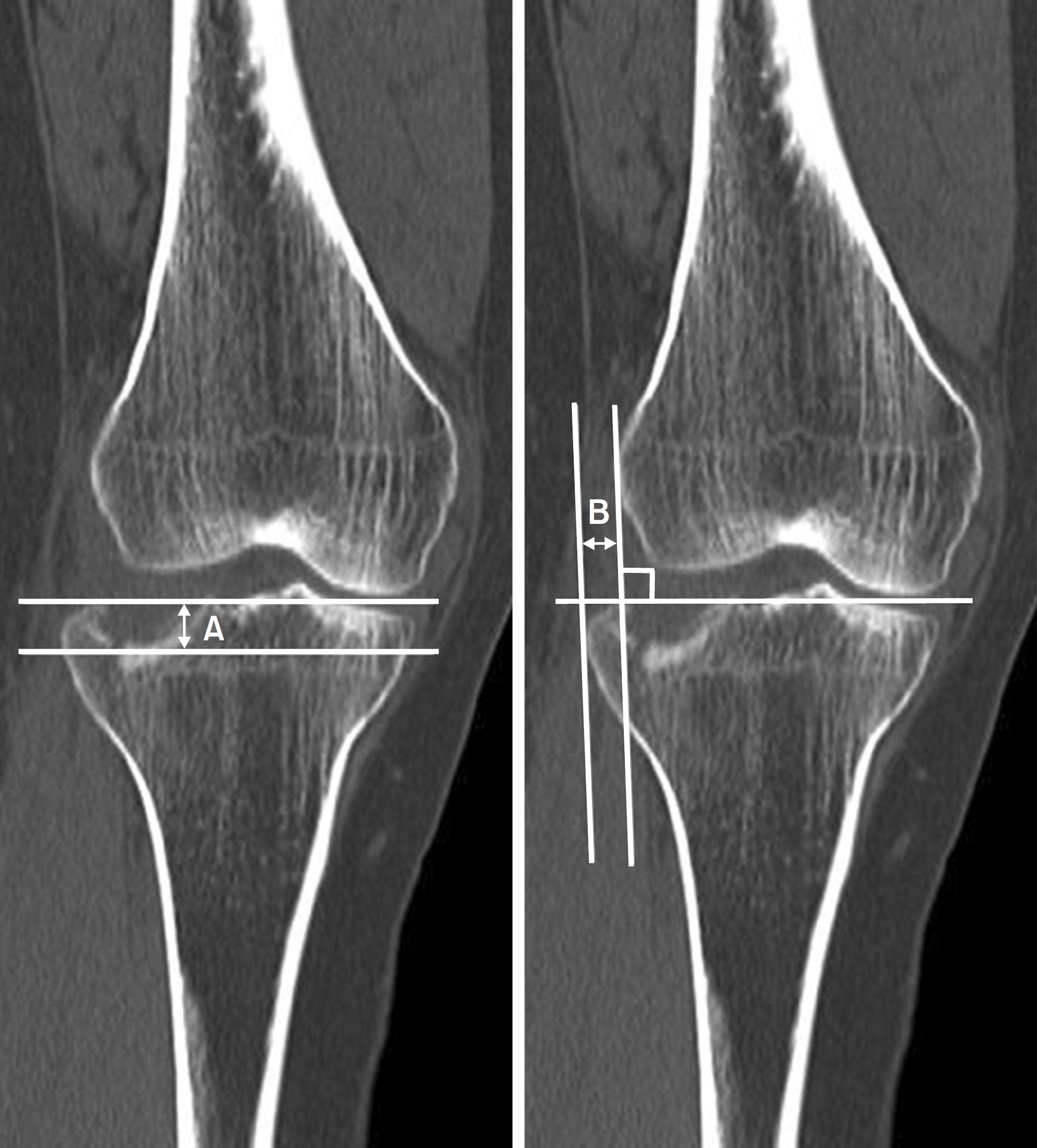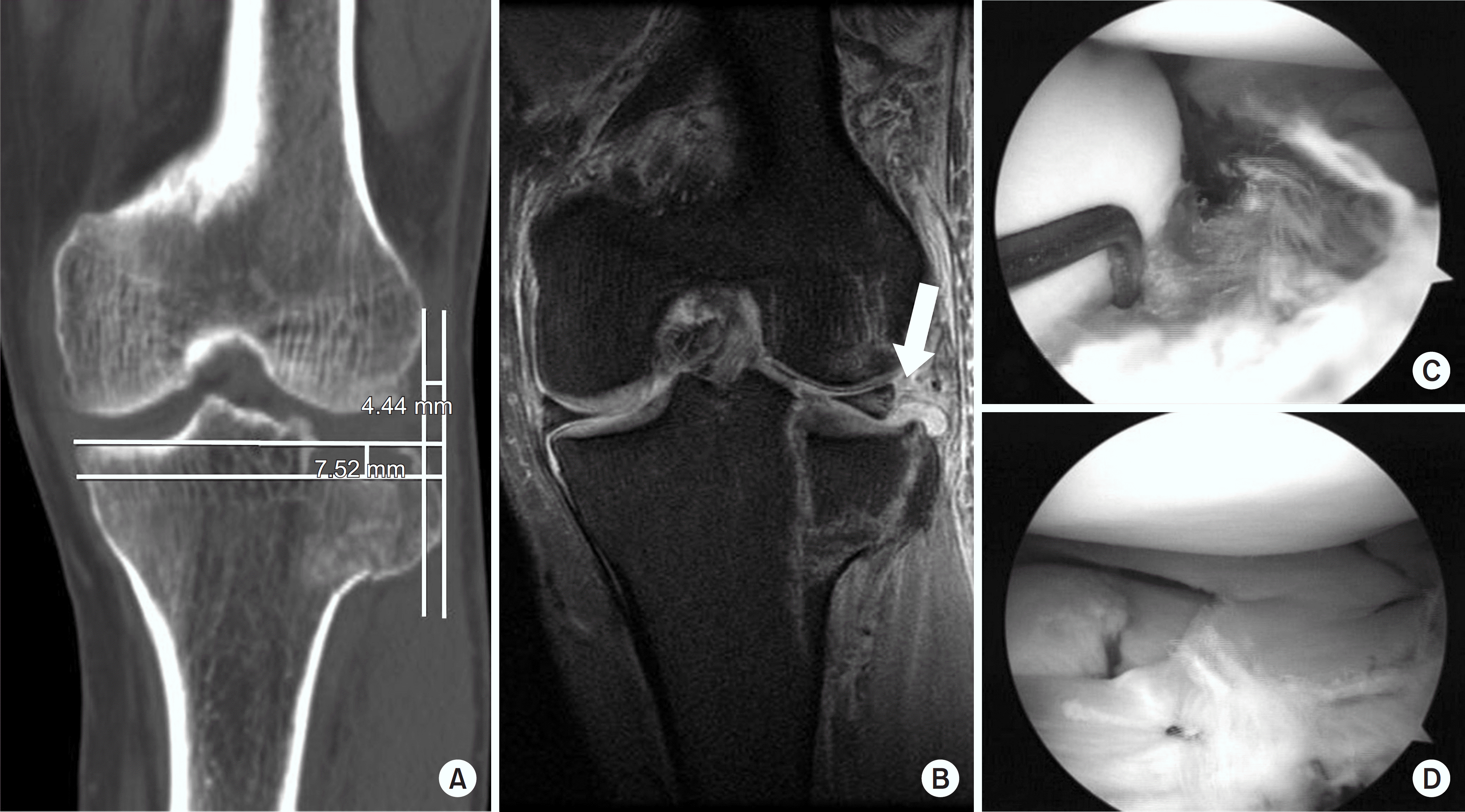Abstract
Purpose
This study examined whether any fracture pattern shown in computed tomography (CT) scan is associated with the presence of lateral meniscus (LM) injury in a tibia plateau fracture.
Materials and Methods
Fifty-three tibia plateau fractures with both preoperative CT and magnetic resonance imagings (MRI) available were reviewed. The patient demographics, including age, sex, body mass index, and energy level of injury were recorded. The fracture type according to the Schatzker classification, patterns including the lateral plateau depression (LPD), lateral plateau widening (LPW), fracture fragment location, and the number of columns involved were assessed from the CT scans. The presence of a LM injury was determined from the MRI. The differences in the factors between the patients with (Group 1) and without (Group 2) LM injuries were compared and the correlation between the factors and the presence of LM injury was analyzed.
Results
The LM was injured in 23 cases (Group 1, 43.4%) and intact in 30 cases (Group 2, 56.6%). The LPD in Group 1 (average, 8.2 mm; range, 3.0–20.0 mm) and Group 2 (average, 3.8 mm; range, 1.4–12.1 mm) was significantly different (p<0.001). The difference in LPW of Group 1 (average, 6.9 mm; range, 1.2–15.3 mm) and Group 2 (average, 4.8 mm; range, 1.4–9.4 mm) was not significant (p=0.097). The other fracture patterns or demographics were similar between in the two groups. Regression analysis revealed that an increased LPD (p=0.003, odds ratio [OR]=2.12) and LPW (p=0.048, OR=1.23) were significantly related to the presence of a LM tear.
Go to : 
References
1. Lee SY, Jee WH, Jung JY, Koh IJ, In Y, Kim JM. Lateral menis-cocapsular separation in patients with tibial plateau fractures: detection with magnetic resonance imaging. J Comput Assist Tomogr. 39:257–262. 2015.
2. Stannard JP, Lopez R, Volgas D. Soft tissue injury of the knee after tibial plateau fractures. J Knee Surg. 23:187–192. 2010.

3. Abdel-Hamid MZ, Chang CH, Chan YS, et al. Arthroscopic evaluation of soft tissue injuries in tibial plateau fractures: retrospective analysis of 98 cases. Arthroscopy. 22:669–675. 2006.

4. Park HJ, Lee HD, Cho JH. The efficacy of meniscal treatment associated with lateral tibial plateau fractures. Knee Surg Relat Res. 29:137–143. 2017.

5. Dodd A, Oddone Paolucci E, Korley R. The effect of three-dimensional computed tomography reconstructions on preoperative planning of tibial plateau fractures: a case-control series. BMC Musculoskelet Disord. 16:144. 2015.

6. Forman JM, Karia RJ, Davidovitch RI, Egol KA. Tibial plateau fractures with and without meniscus tear: results of a standardized treatment protocol. Bull Hosp Jt Dis (2013). 71:144–151. 2013.
7. Ruiz-Ibán MÁ. Diaz-Heredia J, Elias-Martín E, Moros-Marco S, Cebreiro Martinez Del Val I. Repair of meniscal tears associated with tibial plateau fractures: Repair of meniscal tears associated with tibial plateau fractures: a review of 15 cases. Am J Sports Med. 40:2289–2295. 2012.
8. Stahl D, Serrano-Riera R, Collin K, Griffing R, Defenbaugh B, Sagi HC. Operatively treated meniscal tears associated with tibial plateau fractures: a report on 661 patients. J Orthop Trauma. 29:322–324. 2015.
9. Chen P, Shen H, Wang W, Ni B, Fan Z, Lu H. The morphological features of different Schatzker types of tibial plateau fractures: a three-dimensional computed tomography study. J Orthop Surg Res. 11:94. 2016.

10. Dirschl DR, Dawson PA. Injury severity assessment in tibial plateau fractures. Clin Orthop Relat Res. 423:85–92. 2004.

11. Lawler LP, Corl FM, Fishman EK. Multi- and single detector CT with 3D volume rendering in tibial plateau fracture imaging and management. Crit Rev Comput Tomogr. 43:251–282. 2002.
12. Mui LW, Engelsohn E, Umans H. Comparison of CT and MRI in patients with tibial plateau fracture: can CT findings predict ligament tear or meniscal injury? Skeletal Radiol. 36:145–151. 2007.

13. Kode L, Lieberman JM, Motta AO, Wilber JH, Vasen A, Yagan R. Evaluation of tibial plateau fractures: efficacy of MR imaging compared with CT. AJR Am J Roentgenol. 163:141–147. 1994.

14. Wang J, Wei J, Wang M. The distinct prediction standards for radiological assessments associated with soft tissue injuries in the acute tibial plateau fracture. Eur J Orthop Surg Traumatol. 25:913–920. 2015.

15. Yacoubian SV, Nevins RT, Sallis JG, Potter HG, Lorich DG. Impact of MRI on treatment plan and fracture classification of tibial plateau fractures. J Orthop Trauma. 16:632–637. 2002.

16. Rozell JC, Vemulapalli KC, Gary JL, Donegan DJ. Tibial plateau fractures in elderly patients. Geriatr Orthop Surg Rehabil. 7:126–134. 2016.

17. Shimizu T, Sawaguchi T, Sakagoshi D, Goshima K, Shigemoto K, Hatsuchi Y. Geriatric tibial plateau fractures: clinical features and surgical outcomes. J Orthop Sci. 21:68–73. 2016.

18. Markhardt BK, Gross JM, Monu JU. Schatzker classification of tibial plateau fractures: use of CT and MR imaging improves assessment. Radiographics. 29:585–597. 2009.

19. Wang Y, Luo C, Zhu Y, et al. Updated three-column concept in surgical treatment for tibial plateau fractures: a prospective cohort study of 287 patients. Injury. 47:1488–1496. 2016.
20. Trikalinos TA, Hoaglin DC, Schmid CH. An empirical comparison of univariate and multivariate meta-analyses for categorical outcomes. Stat Med. 33:1441–1459. 2014.

21. Gardner MJ, Yacoubian S, Geller D, et al. Prediction of soft-tissue injuries in Schatzker II tibial plateau fractures based on measurements of plain radiographs. J Trauma. 60:319–323. 2006.

22. Durakbasa MO, Kose O, Ermis MN, Demirtas A, Gunday S, Islam C. Measurement of lateral plateau depression and lateral plateau widening in a Schatzker type II fracture can predict a lateral meniscal injury. Knee Surg Sports Traumatol Arthrosc. 21:2141–2146. 2013.

23. Ringus VM, Lemley FR, Hubbard DF, Wearden S, Jones DL. Lateral tibial plateau fracture depression as a predictor of lateral meniscus pathology. Orthopedics. 33:80–84. 2010.

24. Spiro AS, Regier M, Novo de Oliveira A, et al. The degree of articular depression as a predictor of soft-tissue injuries in tibial plateau fracture. Knee Surg Sports Traumatol Arthrosc. 21:564–570. 2013.

Go to : 
 | Fig. 1.Lateral plateau depression (LPD) and lateral plateau widening (LPW) measurements from a coronal reformatted computed tomography imaging. LPD was defined as the perpendicular distance ‘A’ between a tangential line to the neutral plane of the articular surface and a tangential line to the lowest point of depression. LPW was defined as the perpendicular distance ‘B’ between a tangential line to the lateral femoral epicondyle and a parallel line drawn from the most lateral part of the lateral tibial plateau. |
 | Fig. 2.A 52-year-old man presented with a Schatzker type II tibia plateau fracture of the left knee. (A) Computed tomography coronal reformatted imaging demonstrated 7.52 mm of lateral plateau depression and 4.44 mm of lateral plateau widening. (B) Meniscocapsular separation and central migration of lateral meniscus (white arrow) was shown in the coronal magnetic resonance imaging. (C) Lateral meniscus injury was confirmed during arthroscopy. (D) The lateral meniscus was repaired to the capsule using the inside-out repair technique. |
Table 1.
Demographic and Clinical Characteristics of the Patients
Table 2.
Result of Linear Regression Analysis
| Covariate | Correlation coefficient | p-value | Odds ratio |
|---|---|---|---|
| Age | −0.046 | 0.850 | 0.99 |
| Sex (male=0, female=1) | −0.113 | 0.732 | 0.97 |
| Body mass index | 0.122 | 0.837 | 1.06 |
| Energy level of injury (low=0, high=1) | 0.121 | 0.184 | 1.14 |
| Schatzker type | 1.262 | 0.834 | 0.71 |
| Column involvement (uni=0, multi=1) | 0.082 | 0.752 | 1.18 |
| Lateral plateau depression | 0.250 | 0.003* | 2.12 |
| Lateral plateau widening | 0.074 | 0.048* | 1.23 |




 PDF
PDF ePub
ePub Citation
Citation Print
Print


 XML Download
XML Download